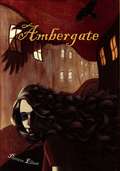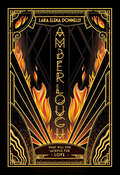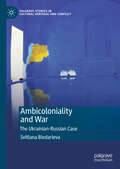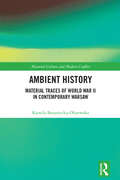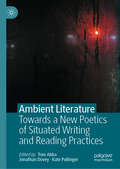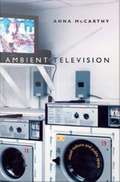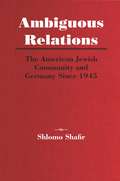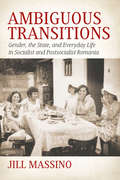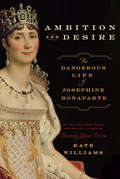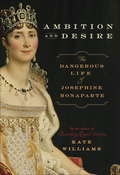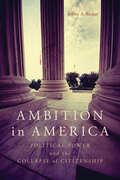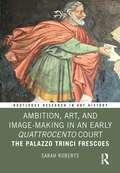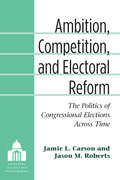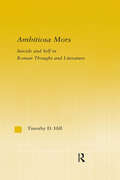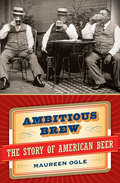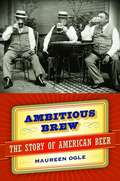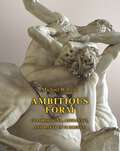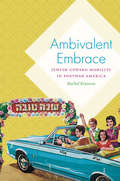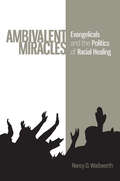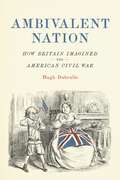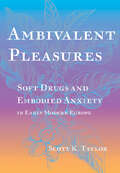- Table View
- List View
Ambergate
by Patricia ElliottI am the girl with no name ... I have a secret I must never tell. If I do, they will come after me - the Protector and his men. Only a number branded on her arm betrays the orphan girl's past. When she arrives at Murkmere Hall to be a kitchen maid, they call her Scuff, and little guess she has committed a terrible crime. Haunted by her dark secret, all Scuff can do is pray to the divine beings - the birds - for forgiveness. Now, five years later, the past is catching up with Scuff. Hunted from all sides, she flees Murkmere, only to be forced back to the cruel confines of the Capital, and the Orphans' Home where it all began.
Amberlough: Book 1 In The Amberlough Dossier (Amberlough Dossier #1)
by Lara Elena DonnellyA double-agent sacrifices all his ideals in order to save his smuggler lover before a government coup takes over their decadent city in Lara Elena Donnelly’s glam spy thriller debut, a Nebula finalist for Best Novel!“Exploring the roots of hatred, nationalism, and fascism, while at the same time celebrating the diversity, love, romance, fashion, and joy the world is capable of producing.” —BookriotIntroducing…The Smuggler: By day, Aristide Makricosta is the emcee for Amberlough City’s top nightclub. By night, he moves drugs and refugees under the noses of crooked cops.The Spy: Covert agent Cyril DePaul thinks he’s good at keeping secrets, but after a disastrous mission abroad, he makes a dangerous choice to protect himself…and hopefully Aristide too.The Dancer: Streetwise Cordelia Lehane, burlesque performer at the Bumble Bee Cabaret and Aristide’s runner, could be the key to Cyril’s plans—if she can be trusted.As the twinkling marquees lights yield to the rising flames of a fascist revolution, these three will struggle to survive using whatever means — and people — necessary. Including each other.“James Bond by way of Oscar Wilde.” —Holly Black“Sparkling with slang, full of riotous characters, and dripping with intrigue, Amberlough is a dazzling romp through a tumultuous, ravishing world.” —Robert Jackson Bennett, winner of the Shirley Jackson Award and the Edgar Award“Astonishing first novel!” —World Fantasy Award-winning author Ellen KushnerAt the Publisher's request, this title is being sold without Digital Rights Management Software (DRM) applied.
Amberly, la esposa perfecta (Trilogía Hermanas Davenport #Volumen 1)
by Verónica MengualDescubre a las hermanas Davenport en esta trilogía. Tres hermanas que harán su «pequeña revolución» dentro de la época en la que les toca vivir. Esta es la historia de Amberly. ¿Será capaz de ser feliz con el odioso señor Kinsley? Hija de un conde sin herederos, lady Amberly Davenport toma la decisión de sacrificarse y entregarse en matrimonio a un rico abogado que lleva tras ella tres años. Ella no lo soporta y él está empecinado en que sea suya por completo, no sin antes darle un escarmiento. Atados finalmente el uno al otro, comienzan un matrimonio tortuoso que hará que Amberly huya despavorida. ¿Podrá él cumplir su cometido?
Ambicoloniality and War: The Ukrainian-Russian Case (Palgrave Studies in Cultural Heritage and Conflict)
by Svitlana BiedarievaThis book proposes a new notion of “ambicoloniality” to speak about the current situation when Ukraine has become Russia's territory of obsession, and Russia, in its desire to occupy Ukraine, has in effect subjected itself to Ukraine’s symbolic dominance. Ambicoloniality presents a key point of divergence from already existing models, as the mutual impact of the two countries over centuries has gone both ways, over a shared border — in contrast to other empires that established their colonial power relations at a distance. The Ukrainian-Russian case is very different from the examples covered by both postcolonial and decolonial theorists. To explore the reasons and consequences of such a differing process of colonial expansion/ anti-colonial struggle/ decolonial release, the book inquires into the historical and cultural reasons for the emerging gap between the two states. It explores which role cultural hybridity plays in political self-identification in both Ukraine and Russia, and how this hybridity has manifested in society and culture (including examples of art and literature) following the dissolution of the Soviet Union in 1991, until 2023.
Ambient History: Material Traces of World War II in Contemporary Warsaw (Material Culture and Modern Conflict)
by Kamila Baraniecka-OlszewskaAmbient History presents the role urban fabric plays in constructing the wartime history of Warsaw. It focuses on history embedded in matter and details the practices followed by municipal institutions, artists and historical reenactors who pull history out of the background through their actions.The book offers a new perspective on the material history of the city. It presents the concept of ambient history – history hidden in the background, in the landscape – waiting to be utilised by individuals coming into contact with the fabric of the city. It draws on anthropological considerations of history which embrace non-academic methods of conceptualising the past and processes of democratising history. The book has two principal objectives. One is to give theoretical grounding to the term ‘ambient history’, which facilitates the conceptualisation of material history and the role experiencing it plays in the process of constructing history. The other is to try and determine the limits of the heuristic potential of posthumanist reflection on materiality in reference to research focused on the making of history.Therefore, the book is valuable reading for researchers studying non-academic methods of curating history: scholars investigating materiality and things, anthropologists of history, scholars of heritage studies, experts in urban studies, historians focused on public history and archaeologists analysing the discipline’s theory.
Ambient Literature: Towards a New Poetics of Situated Writing and Reading Practices
by Kate Pullinger Tom Abba Jonathan DoveyThis book considers how a combination of place-based writing and location responsive technologies produce new kinds of literary experiences. Building on the work done in the Ambient Literature Project (2016–2018), this books argues that these encounters constitute new literary forms, in which the authored text lies at the heart of an embodied and mediated experience. The visual, sonic, social and historic resources of place become the elements of a live and emergent mise-en-scène. Specific techniques of narration, including hallucination, memory, history, place based writing, and drama, as well as reworking of traditional storytelling forms combine with the work of app and user experience design, interaction, software authoring, and GIS (geographical information systems) to produce ambient experiences where the user reads a textual and sonic literary space. These experiences are temporary, ambiguous, and unpredictable in their meaning but unlike the theatre, the gallery, or the cinema they take place in the everyday shared world. The book explores the potentiality of a new literary form produced by the exchange between location-aware cultural objects, writers and readers. This book, and the work it explores, lays the ground for a new poetics of situated writing and reading practices.
Ambient Television: Visual Culture and Public Space
by Anna MccarthyAlthough we tend to think of television primarily as a household fixture, TV monitors outside the home are widespread: in bars, laundromats, and stores; conveying flight arrival and departure times in airports; uniting crowds at sports events and allaying boredom in waiting rooms; and helping to pass the time in workplaces of all kinds. In Ambient Television Anna McCarthy explores the significance of this pervasive phenomenon, tracing the forms of conflict, commerce, and community that television generates outside the home. Discussing the roles television has played in different institutions from 1945 to the present day, McCarthy draws on a wide array of sources. These include retail merchandising literature, TV industry trade journals, and journalistic discussions of public viewing, as well as the work of cultural geographers, architectural theorists, media scholars, and anthropologists. She also uses photography as a research tool, documenting the uses and meanings of television sets in the built environment, and focuses on such locations as the tavern and the department store to show how television is used to support very different ideas about gender, class, and consumption. Turning to contemporary examples, McCarthy discusses practices such as Turner Private Networks' efforts to transform waiting room populations into advertising audiences and the use of point-of-sale video that influences brand visibility and consumer behavior. Finally, she inquires into the activist potential of out-of-home television through a discussion of the video practices of two contemporary artists in everyday public settings. Scholars and students of cultural, visual, urban, American, film, and television studies will be interested in this thought-provoking, interdisciplinary book.
Ambiguous Relations: The American Jewish Community and Germany Since 1945
by Shlomo ShafirThe reemergence of a united Germany as a dominant power in Europe has increased even more it's importance as a major political ally and trade partner of the United States, despite the misgivings of some U.S. citizens. Ambiguous Relations addresses for the first time the complex relationships between American Jews and Germany over the fifty years following the end of World War II, and examines American Jewry's' ambiguous attitude toward Germany that continues despite sociological and generational changes within the community. Shlomo Shafir recounts attempts by American Jews to influence U.S. policy toward Germany after the ware and traces these efforts through President Reagan's infamous visit to Bitburg and beyond. He shows how Jewish demands for justice were hampered not only by America's changing attitude toward West Germany as a postwar European power but also by the distraction of anti-communist hysteria in this country. In evaluating the impact of Jewish pressure on American public opinion and on the West German government, Shafir discusses the rationales and strategies of Jewish communal and religious groups, legislators, and intellectuals, as well as the rise of Holocaust consciousness and the roles of Israel and surviving German Jewish communities. He also describes the efforts of German diplomats to assuage American Jewish hostility and relates how the American Jewish community has been able to influence German soul-searching regarding their historical responsibility and even successfully intervened to bring war criminals to trial. Based on extensive archival research in Germany, Israel, and the Unities States, Ambiguous Relations in the first book to examine this tenuous situation in such depth. It is a comprehensive account of recent history that comes to groups with emotional and political reality.
Ambiguous Transitions: Gender, the State, and Everyday Life in Socialist and Postsocialist Romania
by Jill MassinoFocusing on youth, family, work, and consumption, Ambiguous Transitions analyzes the interplay between gender and citizenship postwar Romania. By juxtaposing official sources with oral histories and socialist policies with everyday practices, Jill Massino illuminates the gendered dimensions of socialist modernization and its complex effects on women’s roles, relationships, and identities. Analyzing women as subjects and agents, the book examines how they negotiated the challenges that arose as Romanian society modernized, even as it clung to traditional ideas about gender. Massino concludes by exploring the ambiguities of postsocialism, highlighting how the legacies of the past have shaped politics and women’s lived experiences since 1989.
Ambiguous Transitions: Gender, the State, and Everyday Life in Socialist and Postsocialist Romania
by Jill MassinoFocusing on youth, family, work, and consumption, Ambiguous Transitions analyzes the interplay between gender and citizenship postwar Romania. By juxtaposing official sources with oral histories and socialist policies with everyday practices, Jill Massino illuminates the gendered dimensions of socialist modernization and its complex effects on women’s roles, relationships, and identities. Analyzing women as subjects and agents, the book examines how they negotiated the challenges that arose as Romanian society modernized, even as it clung to traditional ideas about gender. Massino concludes by exploring the ambiguities of postsocialism, highlighting how the legacies of the past have shaped politics and women’s lived experiences since 1989.
Ambition and Desire
by Kate WilliamsFrom CNN's official royal historian, a highly praised young author with a doctorate from Oxford University, comes the extraordinary rags-to-riches story of the woman who conquered Napoleon's heart--and with it, an empire. Their love was legendary, their ambition flagrant and unashamed. Napoleon Bonaparte and his wife, Josephine, came to power during one of the most turbulent periods in the history of France. The story of the Corsican soldier's incredible rise has been well documented. Now, in this spellbinding, luminous account, Kate Williams draws back the curtain on the woman who beguiled him: her humble origins, her exorbitant appetites, and the tragic turn of events that led to her undoing. Born Marie-Josèphe-Rose de Tascher de La Pagerie on the Caribbean island of Martinique, the woman Napoleon would later call Josephine was the ultimate survivor. She endured a loveless marriage to a French aristocrat--executed during the Reign of Terror--then barely escaped the guillotine blade herself. Her near-death experience only fueled Josephine's ambition and heightened her determination to find a man who could finance and sustain her. Though no classic beauty, she quickly developed a reputation as one of the most desirable women on the continent. In 1795, she met Napoleon. The attraction was mutual, immediate, and intense. Theirs was an often-tumultuous union, roiled by their pursuit of other lovers but intensely focused on power and success. Josephine was Napoleon's perfect consort and the object of national fascination. Together they conquered Europe. Their extravagance was unprecedented, even by the standards of Versailles. But she could not produce an heir. Sexual obsession brought them together, but cold biological truth tore them apart. Gripping in its immediacy, captivating in its detail, Ambition and Desire is a true tale of desire, heartbreak, and revolutionary turmoil, engagingly written by one of England's most praised young historians. Kate Williams's searing portrait of this alluring and complex woman will finally elevate Josephine Bonaparte to the historical prominence she deserves.
Ambition and Desire
by Kate WilliamsFrom CNN's official royal historian, a highly praised young author with a doctorate from Oxford University, comes the extraordinary rags-to-riches story of the woman who conquered Napoleon's heart--and with it, an empire.Their love was legendary, their ambition flagrant and unashamed. Napoleon Bonaparte and his wife, Josephine, came to power during one of the most turbulent periods in the history of France. The story of the Corsican soldier's incredible rise has been well documented. Now, in this spellbinding, luminous account, Kate Williams draws back the curtain on the woman who beguiled him: her humble origins, her exorbitant appetites, and the tragic turn of events that led to her undoing.Born Marie-Josèphe-Rose de Tascher de La Pagerie on the Caribbean island of Martinique, the woman Napoleon would later call Josephine was the ultimate survivor. She endured a loveless marriage to a French aristocrat--executed during the Reign of Terror--then barely escaped the guillotine blade herself. Her near-death experience only fueled Josephine's ambition and heightened her determination to find a man who could finance and sustain her. Though no classic beauty, she quickly developed a reputation as one of the most desirable women on the continent.In 1795, she met Napoleon. The attraction was mutual, immediate, and intense. Theirs was an often-tumultuous union, roiled by their pursuit of other lovers but intensely focused on power and success. Josephine was Napoleon's perfect consort and the object of national fascination. Together they conquered Europe. Their extravagance was unprecedented, even by the standards of Versailles. But she could not produce an heir. Sexual obsession brought them together, but cold biological truth tore them apart.Gripping in its immediacy, captivating in its detail, Ambition and Desire is a true tale of desire, heartbreak, and revolutionary turmoil, engagingly written by one of England's most praised young historians. Kate Williams's searing portrait of this alluring and complex woman will finally elevate Josephine Bonaparte to the historical prominence she deserves.
Ambition in America: Political Power and the Collapse of Citizenship
by Jeffrey A. BeckerMost Americans admire the determination and drive of artists, athletes, and CEOs, but they seem to despise similar ambition in their elected officials. The structure of political representation and the separation of powers detailed in the United States Co
Ambition, A History: From Vice to Virtue
by William Casey KingIs &“ambitious&” a compliment? It depends: &“[A] masterpiece of intellectual and cultural history.&”—David Brion Davis, author of Inhuman Bondage: The Rise and Fall of Slavery in the New World From rags to riches, log house to White House, enslaved to liberator, ghetto to CEO, ambition fuels the American Dream. Yet at the time of the nation's founding, ambition was viewed as a dangerous vice, everything from &“a canker on the soul&” to the impetus for original sin. This engaging book explores ambition&’s surprising transformation, tracing attitudes from classical antiquity to early modern Europe to the New World and America&’s founding. From this broad historical perspective, William Casey King deepens our understanding of the American mythos and offers a striking reinterpretation of the introduction to the Declaration of Independence. Through an innovative array of sources and authors—Aquinas, Dante, Machiavelli, the Geneva Bible, Marlowe, Shakespeare, Thomas Jefferson, and many others—King demonstrates that a transformed view of ambition became possible the moment Europe realized that Columbus had discovered not a new route but a new world. In addition the author argues that reconstituting ambition as a virtue was a necessary precondition of the American republic. The book suggests that even in the twenty-first century, ambition has never fully lost its ties to vice and continues to exhibit a dual nature—positive or negative depending upon the ends, the means, and the individual involved.
Ambition, Art, and Image-Making in an Early Quattrocento Court: The Palazzo Trinci Frescoes (Routledge Research in Art History)
by Sarah RobertsThis study provides new interpretations of the little-known but fascinating Palazzo Trinci frescoes, relating them for the first time both to their physical context and to their social, political, and cultural environment.Chapters show how a humanist agenda subverted the historical and mythical associations more frequently used to promote powerful families, to point the Trinci family in new directions. It also shows how the artists involved adapted established civic, religious, and chivalric imagery in support of these ideas. The book argues that the resulting decorations are highly unusual for the period, in their serious political and social purpose. Positioning the Trinci as bringers of peace, not war, the family is now associated with culture and education and presented as willing to encourage debate about the character of the virtuous ruler and the nature of good government.The book will be of interest to scholars working in art history and Renaissance studies.
Ambition, Competition, and Electoral Reform: The Politics of Congressional Elections Across Time
by Jamie L. Carson Jason Matthew RobertsIn Ambition, Competition, and Electoral Reform, Jamie L. Carson and Jason M. Roberts present an original study of U.S. congressional elections and electoral institutions for 1872-1944 from a contemporary political science perspective. Using data on late nineteenth and early twentieth century congressional elections, the authors test the applicability in a historical context of modern political science theories, assess the effects of institutional reforms, and identify the factors that shape the competitiveness of elections. They present several key findings: the strategic politicians theory is applicable in an era without candidate-centered campaigns; there was an incumbency advantage prior to the full development of candidate-centered campaigns; institutional reforms have had a significant effect on elections; and the degree of electoral competition frequently correlates with elected officials' responsiveness to citizens.
Ambitiosa Mors: Suicide and the Self in Roman Thought and Literature (Studies in Classics)
by T. D. HillFirst Published in 2004. Routledge is an imprint of Taylor & Francis, an informa company.
Ambitious Brew
by Maureen OgleAmbitious Brew, the first-ever history of American beer, tells an epic story of American ingenuity and the beverage that became a national standard. Not always America’s drink of choice, beer finally took its top spot in the nation’s glasses when a wave of German immigrants arrived in the mid-nineteenth century and settled in to re-create the beloved biergartens they had left behind. Fifty years later, the American-style lager beer they invented was the nation’s most popular beverage-and brewing was the nation’s fifth-largest industry, ruled over by titans Frederick Pabst and Adolphus Busch. Anti-German sentiments aroused by World War I fed the flames of the temperance movement and brought on Prohibition. After its repeal, brewers replaced flavor with innovations such as flashy marketing and lite beer, setting the stage for the generation of microbrewers whose ambitions would reshape the brew once again. Grab a glass and a stool as Maureen Ogle pours out the surprising story behind your favorite pint.
Ambitious Brew: The Story of American Beer
by Maureen OgleFrom the Book Jacket: In this first-ever history of American beer, Maureen Ogle tells its epic story, from the German immigrants who invented it to the upstart microbrewers who revived it. Beer might seem as American as baseball, but that has not always been true: Rum and whiskey were the drinks of choice in the 1830s, with only a few breweries making heavy, yeasty English ale. When a wave of Germans arrived in the middle of the nineteenth century, they promptly set about re-creating the pleasures of the biergartens they had left behind. Just fifty years later, the American-style lager beer that they invented was the nation's most popular beverage-and brewing was the nation's fifth-largest industry, ruled by fabulously wealthy titans Frederick Pabst and Adolphus Busch. But anti-German sentiments aroused by World War I inflamed an already aggressive anti-drink campaign (one activist even declared that "the worst of all our German enemies are Pabst, Schlitz, Blatz, and Miller"), and Prohibition ended brewing's first golden age. In the wake of its repeal, brewers replaced flavor with innovations like marketing and lite beer, setting the stage for a generation of microbrewers whose ambitions reshaped the drink. With panoramic scope and sweep, Maureen Ogle creates a portrait of the innovators and entrepreneurs behind our familiar brews and restores an essential piece of our American story. MAUREEN OGLE is a historian and the author of two previous books, All the Modern Conveniences and Key West. She lives in Ames, Iowa, a town of fifty thousand whose only stand-alone liquor store stocks nearly six hundred different beers.
Ambitious Form: Giambologna, Ammanati, and Danti in Florence
by Michael W. ColeAmbitious Form describes the transformation of Italian sculpture during the neglected half century between the death of Michelangelo and the rise of Bernini. The book follows the Florentine careers of three major sculptors--Giambologna, Bartolomeo Ammanati, and Vincenzo Danti--as they negotiated the politics of the Medici court and eyed one another's work, setting new aims for their art in the process. Only through a comparative look at Giambologna and his contemporaries, it argues, can we understand them individually--or understand the period in which they worked. Michael Cole shows how the concerns of central Italian artists changed during the last decades of the Cinquecento. Whereas their predecessors had focused on specific objects and on the particularities of materials, late sixteenth-century sculptors turned their attention to models and design. The iconic figure gave way to the pose, individualized characters to abstractions. Above all, the multiplicity of master crafts that had once divided sculptors into those who fashioned gold or bronze or stone yielded to a more unifying aspiration, as nearly every ambitious sculptor, whatever his training, strove to become an architect.
Ambivalent Conquests: Maya and Spaniard in Yucatan, 1517-1570
by Inga ClendinnenThis is both a specific study of conversion in a corner of the Spanish Empire, and a work with implications for the understanding of European domination and native resistance throughout the colonial world. Dr Clendinnen explores the intensifying conflict between competing and increasingly divergent Spanish visions of Yucatan and its destructive outcomes. She seeks to penetrate the ways of thinking and feeling of the Mayan Indians in a detailed reconstruction of their assessment of the intruders.
Ambivalent Embrace: Jewish Upward Mobility in Postwar America
by Rachel KransonThis new cultural history of Jewish life and identity in the United States after World War II focuses on the process of upward mobility. Rachel Kranson challenges the common notion that most American Jews unambivalently celebrated their generally strong growth in economic status and social acceptance during the booming postwar era. In fact, a significant number of Jewish religious, artistic, and intellectual leaders worried about the ascent of large numbers of Jews into the American middle class. Kranson reveals that many Jews were deeply concerned that their lives—affected by rapidly changing political pressures, gender roles, and religious practices—were becoming dangerously disconnected from authentic Jewish values. She uncovers how Jewish leaders delivered jeremiads that warned affluent Jews of hypocrisy and associated "good" Jews with poverty, even at times romanticizing life in America's immigrant slums and Europe's impoverished shtetls. Jewish leaders, while not trying to hinder economic development, thus cemented an ongoing identification with the Jewish heritage of poverty and marginality as a crucial element in an American Jewish ethos.
Ambivalent Miracles: Evangelicals and the Politics of Racial Healing (Race, Ethnicity, and Politics)
by Nancy D. WadsworthOver the past three decades, American evangelical Christians have undergone unexpected, progressive shifts in the area of race relations, culminating in a national movement that advocates racial integration and equality in evangelical communities. The movement, which seeks to build cross-racial relationships among evangelicals, has meant challenging well-established paradigms of church growth that built many megachurch empires. While evangelical racial change (ERC) efforts have never been easy and their reception has been mixed, they have produced meaningful transformation in religious communities. Although the movement as a whole encompasses a broad range of political views, many participants are interested in addressing race-related political issues that impact their members, such as immigration, law enforcement, and public education policy. Ambivalent Miracles traces the rise and ongoing evolution of evangelical racial change efforts within the historical, political, and cultural contexts that have shaped them. Nancy D. Wadsworth argues that the stunning breakthroughs this movement has achieved, its curious political ambivalence, and its internal tensions are products of a complex cultural politics constructed at the intersection of U.S. racial and religious history and the meaning-making practices of conservative evangelicalism. Employing methods from the emerging field of political ethnography, Wadsworth draws from a decade’s worth of interviews and participant observation in ERC settings, textual analysis, and survey research, as well as a three-year case study, to provide the first exhaustive treatment of ERC efforts in political science. A 2014 CHOICE Outstanding Academic Title
Ambivalent Nation: How Britain Imagined the American Civil War (Conflicting Worlds: New Dimensions of the American Civil War)
by Hugh DubrulleIn Ambivalent Nation, Hugh Dubrulle explores how Britons envisioned the American Civil War and how these conceptions influenced their discussions about race, politics, society, military affairs, and nationalism. Contributing new research that expands upon previous scholarship focused on establishing British public opinion toward the war, Dubrulle offers a methodical dissection of the ideological forces that shaped that opinion, many of which arose from the complex Anglo-American postcolonial relationship.Britain’s lingering feeling of ownership over its former colony contributed heavily to its discussions of the American Civil War. Because Britain continued to have a substantial material interest in the United States, its writers maintained a position of superiority and authority in respect to American affairs. British commentators tended to see the United States as divided by two distinct civilizations, even before the onset of war: a Yankee bourgeois democracy and a southern oligarchy supported by slavery. They invariably articulated mixed feelings toward both sections, and shortly before the Civil War, the expression of these feelings was magnified by the sudden emergence of inexpensive newspapers, periodicals, and books. The conflicted nature of British attitudes toward the United States during the antebellum years anticipates the ambivalence with which the British reacted to the American crisis in 1861. Britons used prewar stereotypes of northerners and southerners to help explain the course and significance of the conflict. Seen in this fashion, the war seemed particularly relevant to a number of questions that occupied British conversations during this period: the characteristics and capacities of people of African descent, the proper role of democracy in society and politics, the future of armed conflict, and the composition of a durable nation. These questions helped shape Britain’s stance toward the war and, in turn, the war informed British attitudes on these subjects.Dubrulle draws from numerous primary sources to explore the rhetoric and beliefs of British public figures during these years, including government papers, manuscripts from press archives, private correspondence, and samplings from a variety of dailies, weeklies, monthlies, and quarterlies. The first book to examine closely the forces that shaped British public opinion about the Civil War, Ambivalent Nation contextualizes and expands our understanding of British attitudes during this tumultuous period.
Ambivalent Pleasures: Soft Drugs and Embodied Anxiety in Early Modern Europe
by Scott K. TaylorAmbivalent Pleasures explores how Europeans wrestled with the novel experience of consuming substances that could alter moods and become addictive. During the early modern period, psychotropic drugs like sugar, chocolate, tobacco, tea, coffee, distilled spirits like gin and rum, and opium either arrived in western Europe for the first time or were newly available as everyday commodities. Drawing from primary sources in English, Dutch, French, Italian, and Spanish, Scott K. Taylor shows that these substances embodied Europeans' anxieties about race and empire, religious strife, shifting notions of class and gender roles, and the moral implications of urbanization and global trade.Through the writings of physicians, theologians, political pamphleteers, satirists, and others, Ambivalent Pleasures tracks the emerging understanding of addiction; fears about the racial, class, and gendered implications of using these soft drugs (including that consuming them would make users more foreign); and the new forms of sociability that coalesced around their use. Even as Europeans' moral concerns about the consumption of these drugs fluctuated, the physical and sensory experiences of using them remained a critical concern, anticipating present-day rhetoric and policy about addiction to drugs and alcohol.
